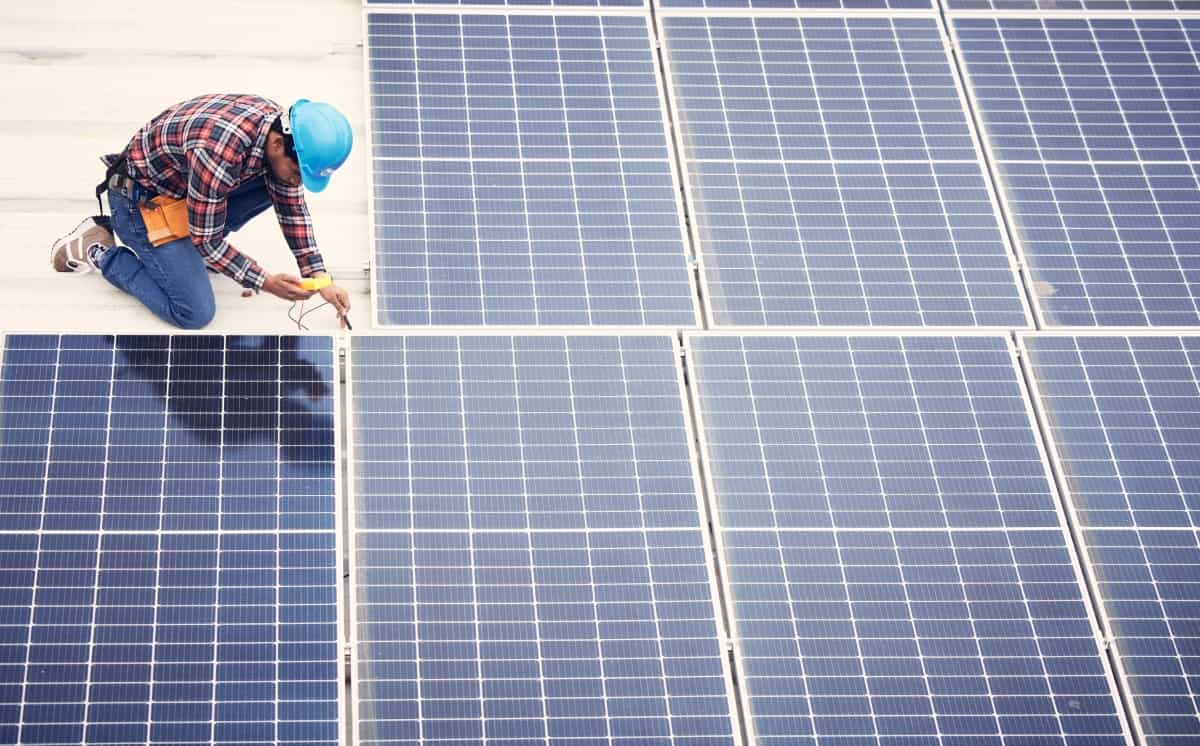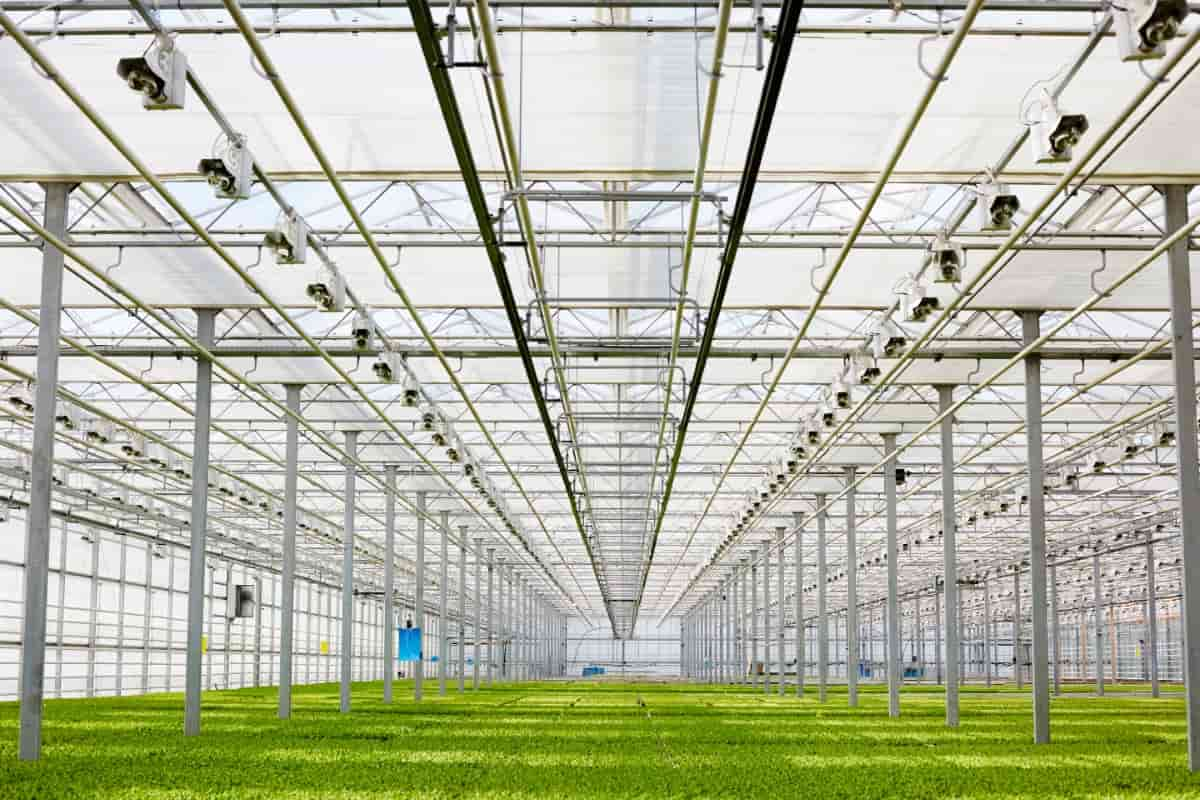Constructing a solar-powered greenhouse presents an ingenious approach to energy conservation. Harnessing the sun’s abundant energy not only nurtures plant life but also minimizes environmental impact. This sustainable endeavor requires meticulous planning and integration of solar technologies.

By seamlessly blending horticulture with cutting-edge energy solutions, we pave the way for eco-friendly cultivation. In this blog, we delve into the precise steps and scientific principles behind creating a solar-powered greenhouse, illustrating innovation and sustainability.
How to Build a Solar-Powered Greenhouse
What Is a Solar-Powered Greenhouse?
A solar-powered greenhouse is a system that uses solar energy to create a suitable environment for plant growth. It can be passive or active. A passive greenhouse uses large windows facing south for maximum sunlight exposure, well-insulated north sides, and transparent roofs and walls. It also has thermal mass to absorb heat during the day and release it at night.
An active solar greenhouse uses solar panels to generate electricity, which can be used to power fans, heaters, lights, pumps, or other devices that regulate temperature, humidity, and ventilation. It can also have a battery or generator for excess electricity storage. Active solar greenhouses are more flexible and efficient but require more investment and maintenance.
Advantages of Using Solar Power for Your Greenhouse
- Reduced energy cost: Relying on renewable energy sources can save money on electricity bills and avoid fluctuations in energy prices.
- Improved yield: By creating a controlled environment for your plants, you can grow them faster, healthier, and more productively.
- Eco-friendly: By using clean energy, you can reduce your greenhouse gas emissions and environmental impact.
- Low maintenance: Solar panels durable and require little maintenance. They can last for 25 years or more with proper care.
- Energy independence: By generating your electricity, you can be less dependent on the grid and avoid power outages or blackouts.
- Scalability: You can easily expand your solar system by adding more panels or batteries as your needs grow.
- Versatility: You can use solar power for various purposes in your greenhouse, such as heating, cooling, lighting, watering, or automation.
Choose the Best Place for Your Solar-Powered Greenhouse
When choosing a solar-powered greenhouse, consider factors such as sun exposure, wind direction, soil quality, water source, and space availability. Sun exposure should be at least six hours per day, with a minimum of six hours in winter. Wind direction should be avoided to prevent damage or temperature reduction.
Soil quality should be good, with tests for pH, nutrients, drainage, and texture before planting. Organic matter, compost, or fertilizers can improve soil condition. A reliable water source, such as rainwater harvesting, wells, springs, or municipal water supply, is essential. Space availability should be sufficient for the greenhouse and solar system, considering the size and shape of the greenhouse and its fit in the landscape.
Design the Layout and Structure of Your Solar-Powered Greenhouse
To design a solar-powered greenhouse, consider factors like the size and shape of the greenhouse, its orientation and slope to maximize sunlight exposure and minimize heat loss, the type and number of solar panels, batteries, and inverters, the ventilation and insulation systems to regulate temperature and humidity, and the layout and arrangement of plants to optimize space and light use and suit gardening goals. These factors will help ensure the greenhouse meets your needs and maintains optimal performance.
In case you missed it: How to Set Up Solar-Powered Hydroponic System: Benefits, Design, and Challenges

Select the Right Materials for Building Your Solar-Powered Greenhouse
When building a solar-powered greenhouse, it is crucial to consider various materials such as wood, metal, plastic, or glass. These materials can impact the greenhouse’s performance, durability, and appearance. Balancing budget with quality expectations is essential, as materials can vary in price.
Durability is another important factor to consider, as materials must withstand the weather conditions in your area and resist pests, rot, rust, or corrosion. Insulation is essential, as materials should retain heat inside the greenhouse and prevent heat loss outside. Transparency is crucial, as materials should allow enough light for plants to grow well and filter out harmful UV rays.
Weight is another factor to consider, as materials should be light enough for the structure to support and easy to transport and install. Common materials include wood, which is a natural and renewable material; metal, which is strong and durable; plastic, which is cheap and lightweight; and glass, which is transparent and elegant.
However, wood can be expensive and require regular maintenance, while metal can be strong and resistant to pests, fire, and weather damage. Plastic is cheap and lightweight but can degrade over time due to exposure to sunlight or chemicals. Glass, on the other hand, is transparent and elegant but can be expensive and fragile and can break or shatter easily if not reinforced properly.
Install Solar Panels to Generate Energy for Your Greenhouse
Solar panels convert sunlight into electricity, consisting of solar cells connected in series or parallel. They can be mounted on the roof or ground of a greenhouse, depending on space availability and sun exposure. To install solar panels, calculate your energy needs based on devices like fans, heaters, lights, pumps, or sensors, and consider the hours of sunlight received per day and the efficiency of your solar panels.
Choose between an off-grid or on-grid solar system type, which depends on batteries or generators for excess electricity storage. Off-grid systems are independent from the utility grid, while on-grid systems are connected to the grid.
Set up An Efficient Watering System for Your Solar-Powered Greenhouse
A solar-powered greenhouse needs a good watering system to keep the plants healthy and hydrated. You can use drip irrigation, sprinklers, or misters to deliver water to your plants. Drip irrigation is the most efficient option, as it uses less water and reduces evaporation. You can also use timers, sensors, or controllers to automate your watering system and adjust it according to the weather and the needs of your plants.
In case you missed it: 9 Ways to Use Solar Energy for Your Garden: Managing Your Garden with Solar Power

Use Special Materials to Control the Temperature in Your Greenhouse
The temperature in your greenhouse depends on the amount of sunlight and heat that enters and leaves the structure. You can use special materials to control the temperature and create a suitable environment for your plants. For example, you can use double-glazed glass, polycarbonate, or fiberglass panels to insulate your greenhouse and reduce heat loss. You can also use shade cloth, reflective film, or curtains to block excess sunlight and lower the temperature.
Add Smart Technology to Monitor and Control Your Solar-Powered Greenhouse
Smart technology can help you monitor and control your solar-powered greenhouse from anywhere. You can use sensors, cameras, or thermometers to measure the temperature, humidity, light, soil moisture, and other variables in your greenhouse. You can also use apps, software, or web platforms to access the data and control your devices remotely. For example, you can turn on or off your fans, heaters, lights, or watering system with a click of a button.
Take Care of And Make Sure Your Solar-Powered Greenhouse Works Well
A solar-powered greenhouse requires regular maintenance and care to work well and produce healthy plants. Check your solar panels, batteries, inverters, and wiring regularly and clean them if needed. You should also inspect your greenhouse structure, ventilation system, watering system, and other equipment for any damage or malfunction. It would help if you also pruned, weeded, fertilized, and harvested your plants regularly to protect them from pests and diseases.
In case you missed it: How to Grow Shankhpushpi Plant: A Step-By-Step Guide

Conclusion
For a solar-powered greenhouse, meticulous planning and integration of photovoltaic panels are imperative. The synergy of sustainable energy sources optimizes environmental friendliness, reducing reliance on conventional power grids. This innovative approach not only fosters energy efficiency but also aligns with the ethos of ecological conservation, marking a significant stride towards a greener future.
- Feed Your Flock for Less: Top 10 Tips to Save on Chicken Feed
- Ultimate Guide to Ossabaw Island Hog: Breeding, Raising, Diet, and Care
- Hatching Answers: The Top 10 Reasons Your Chickens Aren’t Laying Eggs
- Eggs and Economics: Breaking Down the Cost of Raising Backyard Chickens
- Defend Your Greens: Proven Methods to Keep Iguanas Out of Your Garden
- Ultimate Guide to Cinnamon Queen Chicken: A Comprehensive Guide for Beginners
- Ultimate Guide to California Tan Chicken: Breeding, Raising, Diet, Egg-Production and Care
- Ultimate Guide to Marsh Daisy Chicken: Breeding, Raising, Diet, and Care
- 10 Types of Chicken Farming Businesses You Can Start for Profits